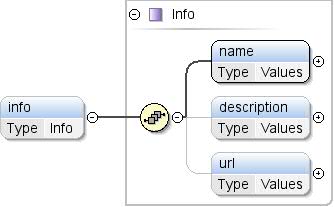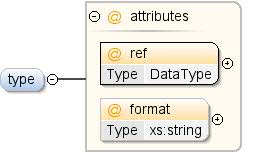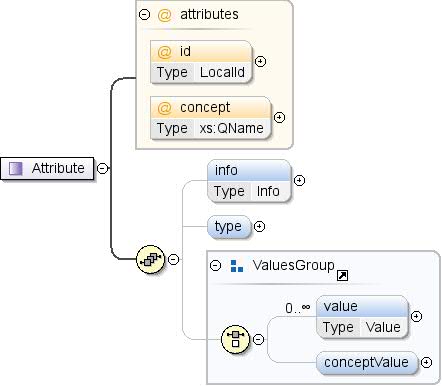元素:屬性 / 資訊
| 命名空間 | http://schemas.google.com/dspl/2010 | ||||
|---|---|---|---|---|---|
| 備註 | 屬性相關文字資訊。 | ||||
| 圖表 |  |
||||
| 類型 | 資訊 | ||||
| 屬性 |
|
||||
| 模型 | name、description{0,1}、url{0,1} | ||||
| 子項時間 | description、name、url | ||||
| 執行個體 |
<info>
<name>{1,1}</name>
<description>{0,1}</description>
<url>{0,1}</url>
</info>
|
||||
| 來源 |
<xs:element name="info" type="Info" minOccurs="0">
<xs:annotation>
<xs:documentation>Textual information about the attribute.</xs:documentation>
</xs:annotation>
</xs:element>
|
元素:屬性 / 類型
| 命名空間 | http://schemas.google.com/dspl/2010 | ||||||||||||||||||
|---|---|---|---|---|---|---|---|---|---|---|---|---|---|---|---|---|---|---|---|
| 備註 | 屬性的資料類型。 | ||||||||||||||||||
| 圖表 |  |
||||||||||||||||||
| 屬性 |
|
||||||||||||||||||
| 屬性 |
|
||||||||||||||||||
| 來源 |
<xs:element name="type" minOccurs="0">
<xs:annotation>
<xs:documentation>The data type of the attribute.</xs:documentation>
</xs:annotation>
<xs:complexType>
<xs:attribute name="ref" type="DataType" use="required"/>
<xs:attribute name="format" type="xs:string" use="optional">
<xs:annotation>
<xs:documentation>A format for the value, used to parse a textual
representation of the values. See [Date formats spec]
for dates.</xs:documentation>
</xs:annotation>
</xs:attribute>
</xs:complexType>
</xs:element>
|
複雜類型:屬性
| 命名空間 | http://schemas.google.com/dspl/2010 | ||||||||||||||||||
|---|---|---|---|---|---|---|---|---|---|---|---|---|---|---|---|---|---|---|---|
| 備註 | 資料集或概念的屬性。 | ||||||||||||||||||
| 圖表 |  |
||||||||||||||||||
| 使用端 |
|
||||||||||||||||||
| 模型 | info{0,1}、type{0,1}, (value* | conceptValue{0,1}) | ||||||||||||||||||
| 子項時間 | conceptValue、info、type、value | ||||||||||||||||||
| 屬性 |
|
||||||||||||||||||
| 來源 |
<xs:complexType name="Attribute">
<xs:annotation>
<xs:documentation>An attribute of a dataset or a concept.</xs:documentation>
</xs:annotation>
<xs:sequence>
<xs:element name="info" type="Info" minOccurs="0">
<xs:annotation>
<xs:documentation>Textual information about the attribute.</xs:documentation>
</xs:annotation>
</xs:element>
<xs:element name="type" minOccurs="0">
<xs:annotation>
<xs:documentation>The data type of the attribute.</xs:documentation>
</xs:annotation>
<xs:complexType>
<xs:attribute name="ref" type="DataType" use="required"/>
<xs:attribute name="format" type="xs:string" use="optional">
<xs:annotation>
<xs:documentation>A format for the value, used to parse a textual
representation of the values. See [Date formats spec]
for dates.</xs:documentation>
</xs:annotation>
</xs:attribute>
</xs:complexType>
</xs:element>
<xs:group ref="ValuesGroup" minOccurs="0"/>
</xs:sequence>
<xs:attribute name="id" type="LocalId" use="optional">
<xs:annotation>
<xs:documentation>The id of the concept attribute. This identifier must be unique within the concept
(across attributes and properties).
The id may be omitted if the concept attribute is specified. In that case, an id is
implicity created with value the local name of the referenced concept. For instance
<attribute concept="unit:currency"/>
is equivalent to
<attribute id="currency" concept="unit:currency"/></xs:documentation>
</xs:annotation>
</xs:attribute>
<xs:attribute name="concept" type="xs:QName" use="optional">
<xs:annotation>
<xs:documentation>A reference to a concept that corresponds to the values of the attribute.
If the attribute specifies a type, then the type must match the type of
the referenced concept.
A reference to an external concept must be of the form "prefix:other_concept_id",
where "prefix" is the prefix used for the namespace of the external dataset
(see XML namespaces).</xs:documentation>
</xs:annotation>
</xs:attribute>
</xs:complexType>
|
屬性:屬性 / 類型 / @ref
| 命名空間 | 沒有命名空間 | ||||||||||||||||||
|---|---|---|---|---|---|---|---|---|---|---|---|---|---|---|---|---|---|---|---|
| 類型 | DataType | ||||||||||||||||||
| 屬性 |
|
||||||||||||||||||
| facet |
|
||||||||||||||||||
| 使用端 |
|
||||||||||||||||||
| 來源 |
<xs:attribute name="ref" type="DataType" use="required"/> |
屬性:屬性 / 類型 / @format
| 命名空間 | 沒有命名空間 | ||
|---|---|---|---|
| 備註 | 值的格式,用來剖析值的文字表示法。請參閱 [日期格式規格] 查看日期。 | ||
| 類型 | xs:string | ||
| 屬性 |
|
||
| 使用端 |
|
||
| 來源 |
<xs:attribute name="format" type="xs:string" use="optional">
<xs:annotation>
<xs:documentation>A format for the value, used to parse a textual
representation of the values. See [Date formats spec]
for dates.</xs:documentation>
</xs:annotation>
</xs:attribute>
|
屬性:屬性 / @id
| 命名空間 | 沒有命名空間 | |||
|---|---|---|---|---|
| 備註 | 概念屬性的 ID,這個 ID 在概念 (所有屬性和屬性) 中不得重複,如果已指定概念屬性,則可省略這個 ID。在這種情況下,系統會透過隱含的概念建立 ID,並以所參照概念的當地名稱做為值。例如 <attribute concept="unit:currency"/> 等同於 <attribute id="currency" concept="unit:currency"/> | |||
| 類型 | LocalId | |||
| 屬性 |
|
|||
| facet |
|
|||
| 使用端 |
|
|||
| 來源 |
<xs:attribute name="id" type="LocalId" use="optional">
<xs:annotation>
<xs:documentation>The id of the concept attribute. This identifier must be unique within the concept
(across attributes and properties).
The id may be omitted if the concept attribute is specified. In that case, an id is
implicity created with value the local name of the referenced concept. For instance
<attribute concept="unit:currency"/>
is equivalent to
<attribute id="currency" concept="unit:currency"/></xs:documentation>
</xs:annotation>
</xs:attribute>
|
屬性:屬性 / @concept
| 命名空間 | 沒有命名空間 | ||
|---|---|---|---|
| 備註 | 對應至屬性值的概念參照。如果屬性指定了類型,則類型必須與所參照概念的類型相符。外部概念參照的格式須為「prefix:other_concept_id」,其中「prefix」是指外部資料集命名空間使用的前置字串 (請參閱 XML 命名空間)。 | ||
| 類型 | xs:QName | ||
| 屬性 |
|
||
| 使用端 |
|
||
| 來源 |
<xs:attribute name="concept" type="xs:QName" use="optional">
<xs:annotation>
<xs:documentation>A reference to a concept that corresponds to the values of the attribute.
If the attribute specifies a type, then the type must match the type of
the referenced concept.
A reference to an external concept must be of the form "prefix:other_concept_id",
where "prefix" is the prefix used for the namespace of the external dataset
(see XML namespaces).</xs:documentation>
</xs:annotation>
</xs:attribute>
|
使用 oXygen XML 編輯器建立。
